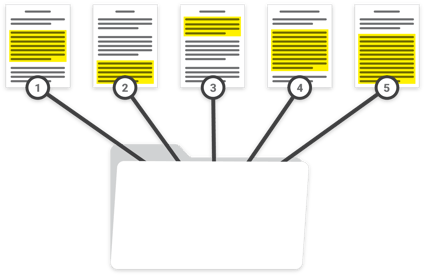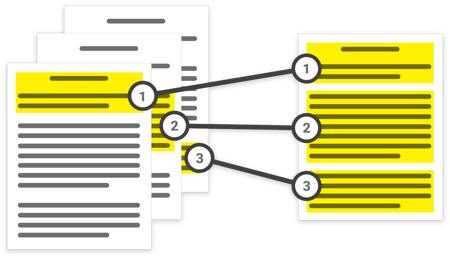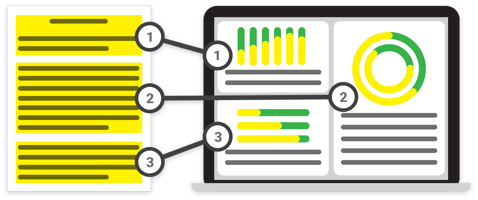Today, the mission of government is broader and more complex than ever before. At all levels – national, state/regional, and local – thousands of agencies and departments are interacting with each other and countless other stakeholders through millions of pages of documents.
Documents are an efficient way to capture and convey information between people and, as a result, written documents are routinely required for all aspects of government operations to enable citizen participation and transparency. But documents are inefficient to create, and the vital information contained in documents is extremely time-consuming and expensive to extract and store in an accessible manner, to analyze for insights, and to share across business systems or with other stakeholders.
This “document dysfunction” multiplies the burdens of government and results in an enormous range of missed opportunities.
But a new approach is now possible. Recent advances in Document Engineering now enable us to bring document content to the existing Line-of-Business Systems used inside government agencies and between those agencies and their stakeholders and constituents, potentially revolutionizing every aspect of government.
The result? Greater insight and transparency, improved engagement between government and the private sector, elimination of government waste and inefficiency, and, ultimately, more effective governance.
Documents are how governments conduct the business of serving the public interest and can take many forms: RFPs, bids, contracts, invoices for goods and services, descriptions of hundreds of government programs designed to assist businesses and individuals, oversight reports for government and citizen accountability, documents soliciting citizen input on government decisions, meeting records as well as the countless emails, letters, comments, and other ways citizens provide input.
Documents are also how governments shape and communicate policy: laws enacted by legislatures, budgets, executive orders, and regulations and guidance issued by agencies. At every level, government policies, actions, and services are defined and implemented through written documents and the volume of documents generated by government processes continues to increase.
Beyond the myriad types of documents involved in government policymaking and service delivery, the multiple layers of government and private actors create enormous complexity. To take just one example, a major transportation infrastructure project will likely involve national, state, and multiple local government entities, and numerous agencies or departments within each government entity, as well as dozens or even hundreds of private sector companies, nonprofit agencies, community organizations, and thousands of individual citizens.
As you can see, even a single major project quickly becomes a complex web of many entities all interacting through documents that are currently cumbersome and opaque to key stakeholders and business systems.
There’s a lot of talk currently about how Artificial Intelligence or “Big Data” will unlock solutions to society’s intractable challenges. We think it’s great that there’s so much passion and attention devoted to AI and we are always on the lookout for new thoughtful advances. But most of the current workaround AI and Big Data isn’t focused on ways that truly bridge the gap between document dysfunction and efficient information systems and so they are not solutions for government information silos, inefficiency, and waste.

By combining a wide range of AI and other approaches, Docugami’s groundbreaking Document Engineering identifies individual ‘chunks’ of content of all sizes within the unique documents of any organization, as well as how each chunk of content relates to every other chunk.
Most of what people call Big Data these days is usually highly supervised and astronomically expensive machine learning on massive data sets. Most services that say they are AI are really just highly trained vertical tools that are very narrowly targeted at specific types of documents in specific types of industries. Most are focused on moving entire documents through various steps of review and approval, not on the actual content of the documents. Many AI systems are expensive, complex, and require massive IT deployments.
We believe the industry needs a new approach – an approach that harnesses multiple flavors of AI together towards actually understanding the content in documents rather than just routing entire documents through a process. The industry needs an approach that is nimble and powerful enough to focus on “small data,” the specific documents within individual organizations, without costly investments in machine learning on massive data sets – not to mention the potential errors and bias such data sets can create. What is needed is an approach that can be used on Day One by frontline office workers and managers in their existing workflows and which doesn’t require armies of consultants and big IT investments.
Fortunately, recent advances in Document Engineering have finally provided the tools for understanding the organization of data and information hidden inside all the documents generated by governments.
Docugami’s Document Engineering approach is new and groundbreaking in multiple ways. By combining a wide range of AI and other approaches, we can identify individual ‘chunks’ of the content of all sizes within a wide range of documents as well as how each chunk of content relates to every other chunk in the document. Docugami automatically creates a hierarchical data representation of each document, making it easy and efficient to assemble new documents, generate insights and reports, and drive line-of-business systems. Docugami is designed for frontline workers and managers and does not require massive investments in machine learning, staff training, IT development, or armies of consultants.
Identifying the chunks of information and insights stored in documents will revolutionize transparency, collaboration, efficiency, and effectiveness across every aspect of government, from policy development and public engagement to procurement and service delivery.
This approach brings document content to the Line-of-Business Systems used inside government agencies and between those agencies and their constituents. To understand some of the capabilities Docugami will bring to government operations and policymaking it may be useful to consider a well-known major infrastructure project like the Big Dig highway and tunnel project in Boston.
Docugami’s Document Engineering approach can dramatically streamline the creation of documents with greater accuracy and consistency across documents.
|
Infrastructure projects require moving a literal mountain of paper. For example, years before construction even began, Boston’s Big Dig project had already issued design contracts worth $165 million to more than 100 businesses. Docugami could have helped government contractors, businesses, and non-governmental organizations as they created a wide range of documents and interacted with the government. The result would have been improved productivity, accountability, and compliance for both government and the private sector. |

Docugami’s Document Engineering approach can dramatically streamline the creation of documents with greater accuracy and consistency across documents.
Docugami’s Document Engineering approach makes it easy to quickly identify chunks of information in documents and based on their values automatically triggers defined workflows to ensure the right insights are getting to the right people and systems at the right time.
|
Using our example, the Big Dig involved multiple government stakeholders at various levels of government – including city, county, regional transportation, state, and federal agencies. With Docugami, contracts and project schedules can easily be deconstructed into information chunks and moved between different agencies and other stakeholders to automatically trigger a wide range of actions – procuring additional materials, allocating workforce or other resources, and scheduling inspections of completed work. The ability to utilize individual chunks of information currently buried inside documents to drive business systems will speed project completion, improve safety, and save money. |
With trillions of stored documents containing critical business insights ‘hidden’ in plain sight, government organizations can use Docugami’s superpowers to turn documents into structured hierarchical data that machines can understand automatically and cross-query alongside other critical governmental databases. This helps governmental agencies seeking to address common challenges – e.g., homelessness, economic development, sustainability, racial inequity, etc. – by automating research and streamlining understanding of how other agencies and communities have approached solving these issues. Document Engineering can also help government authorities quickly and efficiently reconstruct decisions and actions taken years or decades ago, to inform present-day actions.
|
The Big Dig was the largest and most expensive highway project in the history of the United States. Spanning more than 30 years, countless documents were created in the planning, design, bid, and construction process. This historical record contains critical information for subsequent engineering or construction in the Big Dig project area, as well as valuable lessons for any future major infrastructure project in the United States or around the globe. Docugami’s groundbreaking Document Engineering capabilities make it possible to turn those documents into data that machines can understand automatically and make available to future teams working in the project area, as well as other agencies and communities that are seeking to learn from this historic project. |
By deconstructing documents into information chunks that analytics and dashboard tools can understand, Docugami gives government and nongovernmental actors the ability to extract insights, create reports, and visualize data.
|
The Big Dig was estimated in 1987 to cost $3.2 billion but by the time the project was completed in 2007 that number had ballooned to $14.8 billion. This massive increase was due mostly to cost overruns associated with change orders and also fraud which sparked an investigation by the Federal Highway Administration (FHWA). With Docugami, documents can be deconstructed into chunks that can power analytics and dashboard tools. As just one example, Docugami could enable project managers to automatically track variations in change orders to identify cost issues earlier and combat waste, fraud, and abuse. |

Docugami gives government knowledge workers the ability to automatically deconstruct the millions of government documents created every year into chunks that can be used to facilitate the creation of new documents, empower government processes, enrich enterprise databases, and fuel analytics and dashboard tools.
With Docugami’s Document Engineering approach, a new process is now possible. We can move away from the old models of government standardization and templates that haven’t worked, to a new model in which government organizations can automatically create, move, store, and understand document content within and across existing line-of-business systems, and between governments and their stakeholders and constituents.
It all starts with giving government knowledge workers the ability to automatically deconstruct the millions of government documents created every year into chunks that can be used to facilitate the creation of new documents, empower government processes, enrich enterprise databases, and fuel analytics and dashboard tools.
Such an approach will enable transformative benefits to government:
Given the central role of documents in government, Docugami’s Document Engineering will ensure document content can be applied more easily to help drive decisions, insight, efficiency, and collaboration. Document Engineering makes possible a future where government is far more transparent, accessible, and accountable to citizens and stakeholders while better serving the public interest.
Stay up-to-date on information from Docugami.